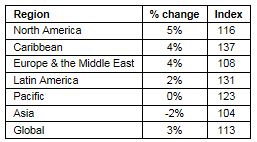DALLAS, March 3, 2015 — The average price paid for a hotel room around the world rose by 3 percent during 2014, compared with 2013, according to the latest Hotels.com® Hotel Price Index™ (HPI®). The overall global economic recovery gathered momentum and consumers became more confident in increasing their travel spending. Hotel prices have now experienced five years of steady price rises since they plummeted during the financial collapse of 2008.
The average price paid by U.S. travelers domestically rose 5 percent to $137, with prices rising in all but two of the Top 50 most popular destinations in the country. Internationally, the strength of the dollar led to price decreases in many of the most popular destinations for American travelers in Latin America and APAC, where travelers received more value for their money.
The global HPI stood at 113 at the end of 2014, 13 points higher than at its launch in 2004 and on a par with its 2008 level but still four points lower than its peak at 117 in 2007.
Johan Svanstrom, president of the Hotels.com brand, said: “Although the Index rose again last year, it is still way behind its peak of seven years ago, which is great news for consumers. Each year is unique in the travel industry and 2014 was no exception, bringing its own opportunities and challenges. Global events, such as the Winter Olympic Games and World Cup, predictably attracted travelers to new destinations. Yet unforeseen tragedies, including the Ebola outbreak, the missing Malaysian Airlines flight MH370 and the loss of MH17 left their own mark.”
Of the six regions in the HPI, the Index rose in four, remained steady in one and fell in another. With a strong economy and rising dollar, North America led the way with a rise of 5 percent, 2 percentage points better than its 2013 result.
Two regions reported 4 percent Index growth. The Caribbean achieved a new record, rising to 137 – the highest yearly regional Index figure ever reached. This was fueled by a stronger U.S. dollar as the Caribbean remained a firm favorite for U.S. travelers. Secondly, Europe and the Middle East showed its fastest rate of growth in seven years, as many countries reported record visitor numbers for the year.
Latin America registered a 2 percent Index rise. World Cup hosts Brazil exceeded expectations when it came to its hospitality industry and the event was a unique opportunity for the country to showcase some of the top class accommodation and services it has to offer.
The Pacific showed no growth in its Index in 2014 but the continued weakness in the Australian dollar should mean that the region will attract more visitors in 2015.
In Asia, the Index decreased by 2 percent. Over the years, the HPI has shown that Asia has long offered the best value destinations in the world and continues to do so.
Svanstrom continued: “More than 1.1 billion travelers ventured abroad in 2014, up nearly 5 percent over the previous year**, with the size of the global domestic travel market estimated to be four to five times this total. Tourism is a fiercely competitive and resilient industry with countries vying to attract valuable visiting travelers by improving infrastructure, expanding hospitality and entertainment options and relaxing visa requirements. Travel opens up both world and minds – so go explore.”
Average percentage price rises in actual prices paid for hotel rooms in 2014
For more information, please visit www.hotels.com/hotel-price-index/
**http://media.unwto.org/press-release/2015-01-27/over-11-billion-tourists-travelled-abroad-2014


